Afte years of playing with camping stoves, writing lots of reviews and having recently given two talks on the topic of ‘The Perfect Stove for Cycle Touring’, I thought I should summarise my findings in a blog post.
So, what is the perfect stove for cycle touring?
That question is discussed in detail below with the pros and cons of each option along with specific recommendations on stoves.
But for those in a hurry or not interested in the minutaie of camping stove design, just read the shortlist below and jump straight to the option recommended.
Best stove for cycling in the UK?
Any free standing gas stove such as:
- Vango Folding Stove (cheap)
- Primus Essentials Stove Set (everything you need in a neat package)
- Kovea Spider (tiny pack size and good in the cold)
- MSR WindPro 2 (premium option that’s good in the cold and the wind)
Go to Option 1: ‘Free Standing Gas Stoves’ below ➜
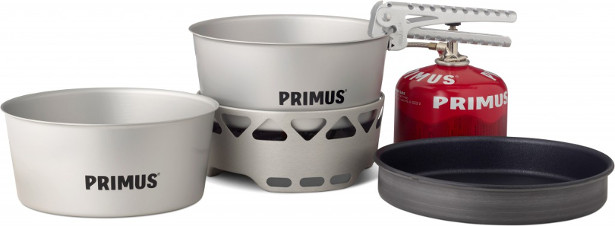
Best stove for cycling overseas?
EITHER A free standing gas stove with adaptors so you can use any type of gas canister:
- Primus Easy Fuel Duo (takes screw-on and easy-clic canisters) plus aerosol and puncture adapters
- Any other free standing gas stove plus all three adaptors (easy-clic, aerosol and puncture)
Go to Option 2: ‘The Any Gas’ stove ➜
OR a multifuel stove that can also take gas. Heavier and more expensive but gives you the best of both worlds: easy to use gas when available and easy to find petrol as a back up:
- Primus OmniFuel / OmniLite Ti
- MSR WhisperLite Universal
- Optimus Polaris
Go to Option 3: Multifuel Stoves ➜
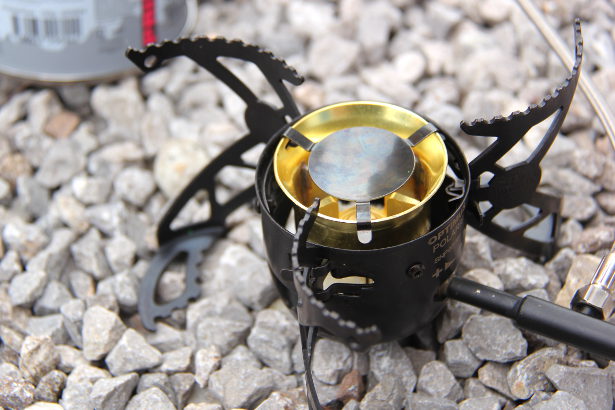
Best stoves for ultralight cycling?
Get a tiny gas stove:
- AlpKit Kraku
- Optimus Crux Lite
Or go seriously light:
- Esbit solid fuel stove
- Alcohol burner
Go to Option 4: Ultralight Stoves ➜
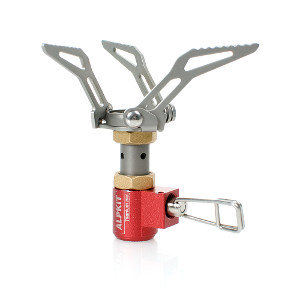
Any other stoves I should think about?
If you’re just boiling water then get a Jetboil style stove. They’re faster and more efficient plus they come in neat little packages which fit neatly into panniers, bikepacking bags and bottle cages:
- Jetboil MiniMo
- MSR WindBurner
- Primus Lite+
- AlpKit BruKit Jackal
Go to Option 5: Jetboil-style stoves ➜
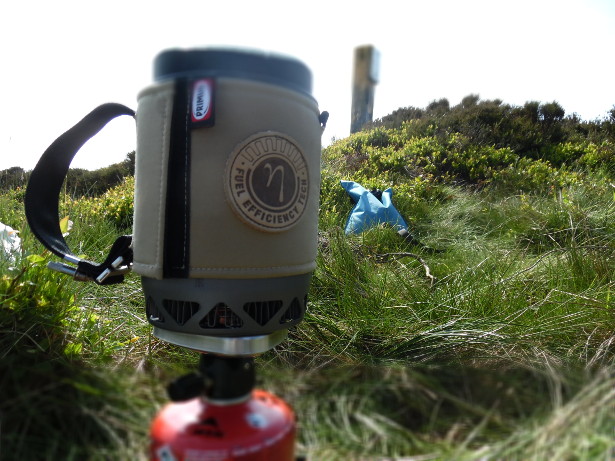
1. Free standing gas stoves
Unless you’re going somewhere really cold (below -10C or 15F) or travelling overseas, I would recommend getting a free standing gas stove.
Free standing means a stove that doesn’t sit on top of the canister. Instead, it will have stand on its own legs (free standing) and connect to the canister with a hose.
Gas means it uses what in the UK we call gas canisters and in the US are just called canisters.
Reasons free standing gas stoves are good for cycle touring:
- Easy to use – light instantly, no mess from dirty fuels and avoid carrying flammable liquid
- Cheap – they start from around £25 and you’ll never spend more than £80
- Lightweight – the heaviest stoves are 350g (12oz)
Limitations of free standing gas stoves:
- Struggle in the cold – below -10C or 15F, gas stoves start to stop working very well. The gas gets too cold and sinks to the bottom of the canister. You can help this by keeping the canister warm or, better still, getting a stove with a ‘preheat tube’. These warm the gas before it gets burned and allow you to turn your canister upside down. Find out which stoves have preheat tubes here.
- You can’t always find gas canisters to buy – canister stoves require canisters and that often means finding a camping store that stocks them. If you’re in the middle of nowhere or overseas, that can be difficult. See the ‘Any Gas’ stove below for some solutions to this problem.
Recommended free standing gas stoves:
If you’re a real stove enthusiast then there are plenty of factors you might like to consider when choosing a stove: size, weight, speed, efficiency, design etc. You can see a comprehensive comparison here. But in most circumstances, they’re all pretty similar and none of them are bad.
Here are a couple of recommendations to get you started:
Vango Folding Stove – £21
This is a decent stove that’s small, doesn’t weigh too much (220g) and currently only costs £21 on Amazon.
Kovea Spider – £44
The Kovea Spider’s key feature is its pack size: it folds down almost flat into a small, easily stored package. It’s lightweight (168g) and has a pre-heat tube so you can turn your canister upside down and keep cooking in the cold.
Primus Essential Stove Set – £80 (inc. pans)
The perfect all-in-one package: a stove, a windshield, two pots and a frying pan lid that all nestle together neatly. (For those familar with Trangias, it’s exactly like that except using gas rather than meths).
There’s also a smarter, lighter set with heat exchangers on the pots (which save fuel and cook faster) called the PrimeTech Stove Set.
MSR WindPro II – £80
The premium option, the MSR Wind Pro is designed to be used in windy conditions and its preheat tube means it’ll work in the cold too.
Summary
A free standing gas stove is the safest bet and the easiest option. Only look at others if you’re going overseas, camping out below -10C/15F or counting every gram. If in doubt, get a free standing gas stove.
2. The ‘Any Gas’ stove
One of the weaknesses of the freestanding gas stoves recommended above is that it can sometimes be hard to find somewhere selling the right type of canister for your stove.
This is particularly difficult when travelling through multiple countries, as you often do on a cycle tour. Every country and region of the world seems to have its own preferred type of gas canister.
There are two solutions to this problem:
- Buy a stove that is compatible with more than one type of gas canister
- Buy adapters that allow you to use your regular camping stove with any type of gas canister
I’ve written a full, detailed guide to all the different types of gas canister. That same article also details the best stoves and adaptors.
Gas stoves vs petrol stoves
It used to be that long distance cyclists wouldavoid this problem by taking a petrol stove, safe in the knowledge that petrol is available everywhere. But these days you can get camping gas in most places too with a bit of effort. We certainly managed to get it in the 23 different countries we cycled through, even without the adaptors described below.
You can still take a petrol stove (they’re discussed below) but gas stoves are much cheaper, cleaner and easier to use than petrol ‘multi fuel’ stoves so I’d always recommend trying the adaptors below first.
Recommended ‘Any Gas’ stoves
Any of the ‘free standing gas stoves’ recommended above will work well with any of the gas canister adaptors. However, if you want one stove that can use two different types of gas canister, try these:
[one_third]
Primus Easy Fuel Duo
[/one_third]
[one_third]
Primus Express Duo
[/one_third]
[one_third_last]
MSR SuperFly
[/one_third_last]
Recommended adaptors:
To find out about the four different types of camping gas canisters and the adaptors you need to use them, see my Guide to Camping Gas Canisters.
Summary
If you’re travelling overseas then get a free standing gas stove (described above) and carry a couple of adaptors so that you can use whatever gas canisters are available locally.
3. Multifuel stove
Multi-fuel camping stoves, also called liquid fuel stoves or petrol stoves, are camping stoves that can burn a variety of liquid fuels. Typically, they can take petrol like you put in your car and clean ‘white fuel’ that you buy from camping stores.
For full details of multifuel stoves, see my comprehensive comparison of every multifuel stove available.
Advantages of multifuel stoves for cycle touring:
- They work well in the cold (even below -10C / 15F)
- You can always get petrol, wherever you are
- Liquid fuel is cheaper than gas canisters
Disadvantage of multifuel stoves for cycling touring:
- They’re fiddly to use – you have to dribble out some fuel, light it, let it warm the stove then turn it on at just the right time. If you get it wrong, you can make a mess and have to start again.
- They’re messy – you’re carying a bottle of flammable liquid and the stoves often get covered in soot
- They’re temperamental – unless used carefully with clean fuel, they can require a lot of cleaning and maintenance
- They’re expensive – compared to gas stoves
- They’re bigger and heavier – compared to gas stoves
Recommended multifuel stoves:
For a review of every multifuel stove available, see my Comparison of Multi Fuel Camping Stoves. However, for cycle touring there are just three that I’d recommend: the Optimus Polaris, Primus Omnifuel/OmniLite and MSR WhisperLite Universal.
Those three can all take gas canisters as well as petrol and other liquid fuels. That means you get the benefits of a gas stove (clean and easy to use) but with the added benefit that, if it’s really cold or you can’t find gas canisters, you can switch to using petrol. There are a few other multifuel stoves that can take gas canisters (see here) but those are your safest bets. They’re all excellent.
1. Primus Omnifuel / OmniLite Ti – £133
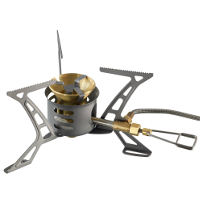
I’ve used, abused and repaired dozens of Primus OmniFuel stoves over the last ten years and know them to be robust, reliable stoves. The titanium version, the OmniLite Ti, is the lightest of the lot and served us well while cycling around the world.
I am biased after years of using them but these are my favourite multifuel stoves.
2. MSR WhisperLite Universal – £110
MSR are the best known multi-fuel stove manufacturers. Their WhisperLite is a classic. You want their newer WhisperLite Universal model which can take gas canisters.
The MSR Whipserlite Universal is a safe bet.
Check price online ➜
3. Optimus Polaris – £135

The Optimus Polaris Optifuel has one key advantage over the two models above. Both of them require you to remove and replace a tiny nozzle every time you switch between using liquid fuel and gas canisters. The Polaris, however, can burn any type of fuel without having to change parts.
You can read a full explanation of this in my review here but, in short, it’ll save you time and effort.
Summary
If you can afford one and don’t mind carrying a few extra ounces, a multifuel stove that takes gas canister is the best choice for an international cycle tour.
4. Tiny, ultralight stove
The three stove set-ups above should cover the vast majority of situations. However, if you want something really small and ultra light then consider the following.
Advantages of ultralight stoves:
The advantages of ultralight stoves are straightforward: they’re smaller and lighter than anything else.
Disadvantages of ultralight stoves:
The downsides of ultralight stoves will vary depending on the type of stove you choose but they all boil down to one thing: practicality.
- Harder to balance pans on – the burners are small and they sit on top of the gas canister so have a high centre of gravity
- Small burners – the heat tends to be high and focused which can result in some food burning whilst the other stays cold
The ultralight gas stoves are as easy to use as the ones above but are
Recommended ultralight stoves:
AlpKit Kraku – £24
The lightest gas stove you can buy, the Alpkit Kraku weighs just 45g and is absolutely tiny. Combine it with a titanium MytiMug 650 cooking pot and you’ll have a complete cooking set for a a total weight of just 125g. Plus, a 100g gas canister will nest inside the pot nicely.
Optimus Crux Lite – £28
Fora a couple of quid and a few grams more (72g in total), the Crux Lite offers a wider flame and faster boil times than the Kraku. It also folds in half so you can fit it into the curvature at the bottom of a gas canister.
The same stove comes in a package with a neat heat-exchanger pot and frying pan lid branded as the Elektra FE. This combination is the fastest I’ve ever tested.
Esbit solid fuel stoves – from £6
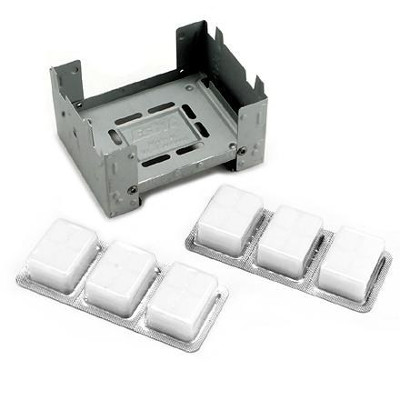
For the ultralight purist, an alternative to gas is solid fuel: small white blocks like firelighters. Solid fuel stoves were invented by Esbit who are still the main manufacturer.
They’re popular because they’re so simple and light. However, they’re slow, you can’t control their heat output and you’re committed to burning a block at a time.
Alcohol burners – from free
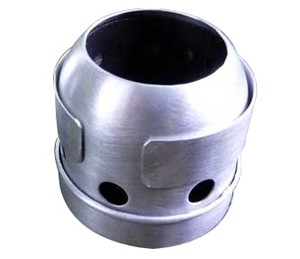
Even lighter than a solid fuel stove is one that burns alcohol. Bear Bones Bikepacking currently sell one that weighs just 8g.
You can make your own alcohol stove out of an old beer/coke can: see video here.
Summary
If saving space and weight is more important to you than practicality and ease of use, get an Alpkit Kraku or Optimus Crux Lite.
If you’re counting every gram and cooking really simple food then consider an Esbit solid fuel or alcohol burner.
5. Jetboil-style stove
The final type of stoves to consider are Jetboil type stoves: all in one units that are designed to boil water quickly and efficiently
Advantages of Jetboil-style stoves
- Fast – boil water quicker than most other stoves
- Efficient – use less gas than other stoves
- Neat packages – the burners and/or gas canisters fit inside the pots making for easy transportation
- Fit in bottle cages – the narrower pots often allow you to fit the stove into an adjustable bottle cage which is great for bikepacking
Disavantages of Jetboil-style stoves
- Can’t cook meals – they’re tall and narrow so good for heating water but not for cooking food (except the Jetboil Sumo, MiniMo and MicroMo and Kovea Alpine Pot)
- Expensive – compared to normal stoves (although they do usually include pot, cup and lighter)
Recommended Jetboil-style stoves
Jetboil MiniMo – £111
Jetboil invented this style of stove and all of their products are top quality. The MiniMo gets a mention because it’s one of the few that’s wide enough to allow proper cooking. You can save weight with a MicroMo or cook for a group with a Sumo.
MSR WindBurner – £98
One issue with gas stoves is their susceptibility to wind. The MSR WindBurner, which is an excellent stove in its own right, has built in wind protection.
It’s also one of the narrower pots available meaning it fits neatly into an adjustable bottle cage.
Primus Lite+ – £82
This is a beautifully crafted stove with excellent design and build quality. It’s the smallest all-in-one stove available.
AlpKit BruKit Jackal – £39
As ever, AlpKit offer the cheapest options. I thought their original product, the BruKit, wasn’t very well made (although it was still popular). The update BruKit Jackal and BruKit Wolf are an improvement and still much cheaper than the competition.
Summary
For short trips where you just want to boil water, perhaps for cooking dehydrated meals, Jetboil-style stoves are fast and efficient, and come in a neat package.
Any questions?
Add a comment below.
Further reading:
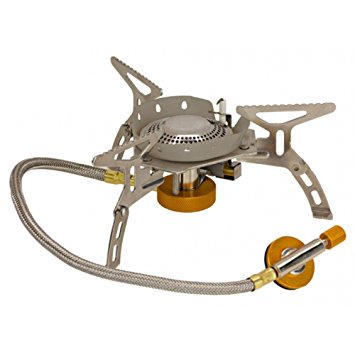
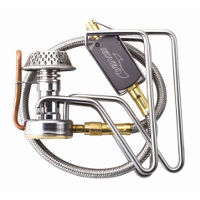
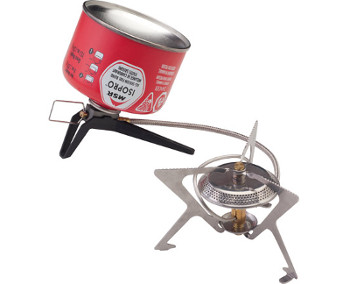

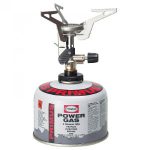
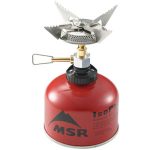
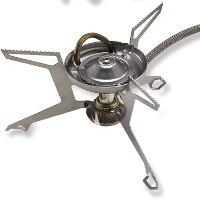
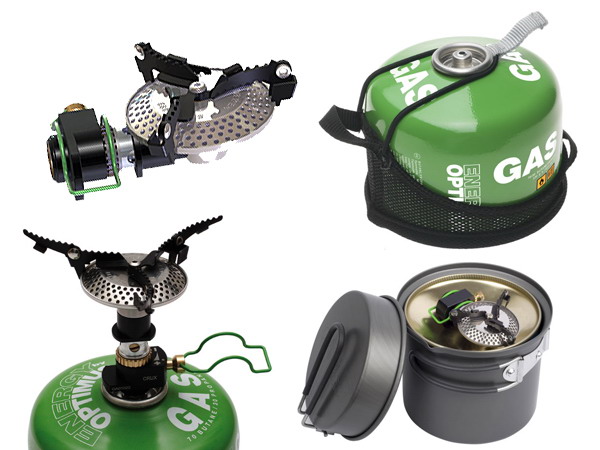
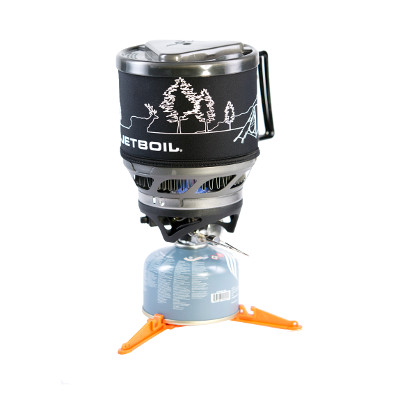
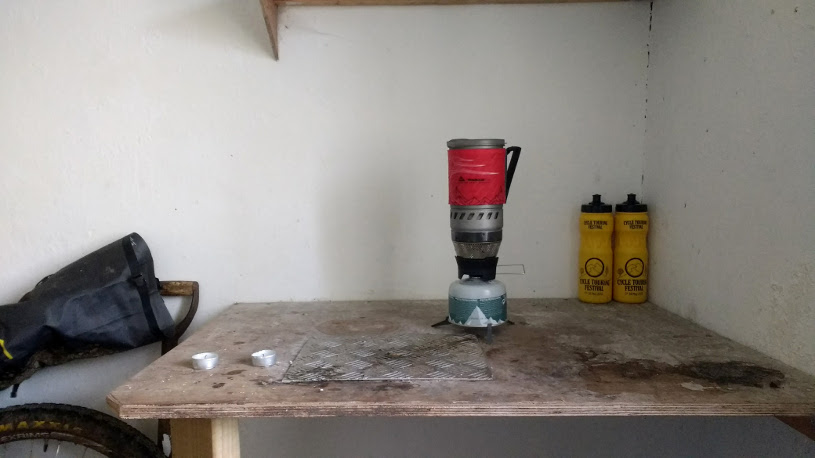
What do you think? Please do add your thoughts below…